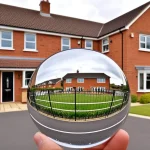Key Features of Traditional British Design
Traditional British design elements are celebrated for their enduring charm and sense of history. Central to British aesthetics are patterned textiles such as florals and tweed, often paired with rich velvets to bring warmth and texture. Classic interior styles favor deep, muted colour palettes—think rich greens, navy blues, and earthy shades—that evoke a cozy atmosphere.
Architectural details play a vital role in defining traditional British interiors. Features such as crown moulding and wainscoting add structure and refinement to rooms. Fireplaces serve both as focal points and practical elements, often framed with ornate woodwork that highlights craftsmanship.
In parallel : How can you integrate vintage elements into a UK home?
Iconic British textiles and materials are widely used to add authenticity. Tweed, originating from Scotland, provides durability and a timeless pattern. Velvet introduces a luxurious feel, while floral motifs reflect England’s love for gardens. Woodwork, especially oak and mahogany, emphasizes quality and tradition in furniture and fittings. Incorporating these traditional British design elements ensures a space rich with character and heritage.
Modern Home Design Principles
Modern interiors emphasize a minimalist aesthetic, focusing on simplicity and open, uncluttered spaces. This approach steers away from ornate details, prioritizing clean lines and functionality. Neutral palettes—whites, greys, and muted earth tones—are foundational in contemporary home style, creating a calm backdrop that feels spacious and inviting.
Have you seen this : How Can You Maximize Comfort in a Small UK Living Space?
Functional furniture plays a key role in modern interiors. Pieces often feature sleek designs and multipurpose use to maximize space and practicality. Clutter-free layouts support ease of movement and a sense of order, aligning with the modern principle of form following function.
Materials commonly used in contemporary homes include polished concrete, glass, and metals, which introduce light and tactile contrast against softer textiles. Finishes tend to be smooth and matte, avoiding excess shine or embellishment.
Overall, the defining characteristic of modern interiors is how they blend utility with aesthetics, creating environments that feel both purposeful and serene. By emphasizing open plans and neutral tones, modern interiors offer a versatile canvas that can be adapted with subtle touches or bold elements as desired.
Key Features of Traditional British Design
Traditional British design elements center on rich patterns, textures, and classic furnishings that evoke warmth and history. Recognisable motifs include floral prints and tweed fabrics, both staples in British aesthetics. These textiles lend tactile interest and a timeless quality to interiors. Velvet, often used in upholstery, adds a sumptuous feel aligned with classic interior styles.
Colour palettes in traditional British design lean towards deep, muted tones—forest greens, burgundy, and navy—creating an inviting and cozy ambiance. These colours complement architectural details such as crown moulding and wainscoting, which introduce elegant lines and a sense of structure to rooms. Fireplaces, often intricately framed with woodwork like oak or mahogany, serve as focal points, celebrating craftsmanship and tradition.
Materials play a key role in defining the style. Tweed originates from Scotland, prized for durability and pattern, while floral motifs reflect England’s garden heritage. Woodwork, especially in dark stained finishes, reinforces the ethos of quality. Integrating traditional British design elements involves combining these textures, colours, and finishes thoughtfully to capture an authentic, timeless style with character.
Key Features of Traditional British Design
Traditional British design elements are centred on rich textures and distinctive patterns that bring warmth and character. Classic interior styles often showcase textiles such as tweed, velvet, and floral prints—each integral to British aesthetics. Tweed offers durability with its heritage ties to Scotland, while velvet adds a sense of luxury, frequently used in upholstery to enhance comfort. Floral motifs reflect England’s longstanding garden traditions, contributing softness and charm to spaces.
Colour schemes typically involve deep, muted tones like forest green, burgundy, and navy blue, which foster a cozy and welcoming atmosphere. Architectural details are essential in traditional British interiors—the use of crown moulding and wainscoting introduces elegance and structural interest. Fireplaces take centre stage as both practical and decorative features, often adorned with hand-crafted woodwork such as oak or mahogany, highlighting skilled craftsmanship.
The interplay of these elements—patterned fabrics, classic furnishings, refined architectural features, and quality materials—defines traditional British design elements, creating interiors that balance comfort, history, and timeless appeal with unmistakable British charm.
Practical Ways to Combine British Design with Modern Homes
Blending traditional British design elements with modern interiors requires thoughtful balance. To fuse traditional with modern successfully, begin by selecting classic furnishings that retain British aesthetics—tweed armchairs or velvet cushions, for example—and pair them with streamlined, minimalist architectural features. This approach respects classic interior styles while maintaining clean, open spaces.
Incorporate British-inspired patterns and textiles subtly to avoid overwhelming modern simplicity. Using florals or tweed as accent pieces—such as cushions or throws—adds texture without clutter. Likewise, placing vintage accessories near contemporary art or lighting creates a layered, transitional decor that feels curated rather than chaotic.
Pay attention to scale and proportion; mixing an ornate fireplace surround with a sleek, modern sofa can work well if materials and colours harmonize. Playing with finishes—matt versus polished wood—also helps bridge styles.
Practical combinations might include a deep green velvet armchair nestled in a bright, neutral room or classic wainscoting softened by modern pendant lights. By mixing these elements carefully, you can create a space that honours British tradition while embracing modern living.
Key Features of Traditional British Design
Traditional British design elements prominently feature rich textures and iconic patterns deeply rooted in British aesthetics. Classic interior styles employ patterned textiles such as tweed, velvet, and florals—each essential to achieving authenticity. Tweed, known for its durability and Scottish heritage, pairs well with velvet’s luxurious softness, commonly found in upholstery. Floral prints reflect England’s garden traditions and add subtle vibrancy to interiors.
Colour schemes characteristic of traditional British design embrace muted, deep tones like forest greens, navy blues, and rich burgundies. These hues create a cozy, inviting atmosphere that complements architectural details including crown moulding and wainscoting. Such woodwork introduces elegance and frame rooms with refined lines.
Fireplaces hold a central role, often framed with handcrafted oak or mahogany, emphasizing timeless craftsmanship. This blend of carefully selected materials, furnishings, and architectural touches defines the essence of traditional British design elements, providing spaces that exude warmth, character, and enduring style rooted firmly in British aesthetics.


